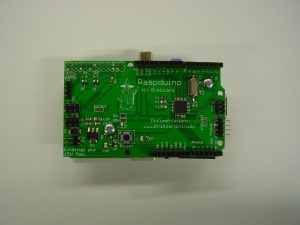Raspduino
This is the documentation page for the BitWizard Raspduino board. The Raspduino is an Arduino compatible microcontroller board, designed to plug on top of a Raspberry Pi. It is then possible to add Arduino shields to the Raspduino.
The Raspduino is equipped with an ATmega328 controller.
Connectors and pinout
The Raspduino of course has the same connectors and pinout as a regular Arduino, and some extra connectors.
Raspberry Pi connectors
The Raspberry Pi has two SPI busses, and one I2C bus. Those are (just like on out Raspberry_Pi_Serial board) broken out to their respective headers, labeled as SPI0, SPI1, and I2C. The signals on these busses are 3V3, but the inputs are 5V tolerant. With the 3V3/5V jumper, you can control what supply voltage is delivered to these connectors. The default setting is 5V.
Power input
It is possible to connect an external power supply on these pins, in case you want to use your Raspduino without a Raspberry Pi.
Extra analog connector
There are two extra analog pins provided on an extra connector, together with a power pin and a GND pin. The power pin supplies the same voltage the Raspduino is running on (default 5V).
LEDs
The Raspduino has two LEDs: A power indicator, and a LED connected to digital pin 13.
Jumpers
The raspduino has a number of jumpers, to configure it for multiple different scenarios.
ICSP/SPI jumper
It is possible to use this connector as an ICSP connector for the AVR, or an SPI connector. By default, this connector is configured as an ICSP connector, but by cutting the trace between the ICSP pad and the center pad, and shorting the center pad to the SPI pad, this connector can be used as an SPI connector. For example to connect one of the the BitWizard SPI expansion boards from the Raspduino.
I2C jumpers
It is possible to connect the Raspberry Pi's I2C bus to the I2C bus of the AVR. To do this, you need to short the SCL and SDA jumpers with a solder bridge.
Serial busses voltage selection jumper
The 3V3/5V jumper next to the Raspberry Pi connector controls the voltage supplied to the connectors that break out the Raspberry Pi's SPI and I2C busses. It is possible to run these busses on 5V or 3V3. 5V Is the default setting, but by cutting the trace between the 5V pad and the center pad, and connecting the 3V3 pad to the center pad with a solder bridge, you can set the supply voltage to 3V3.
AVR voltage selection jumper
It is possible to run the AVR on 5V or 3V3 when the Raspduino is connected to a Raspberry Pi (in theory you'd have to reduce the clock speed to 8MHz if you do this). 5V Is the default setting, but by cutting the trace between the 5V pad and the center pad, and connecting the 3V3 pad to the center pad with a solder bridge, you can set it to work on 3V3.
Powering the Raspduino
You can power the Raspduino in two different ways; By the Raspberry Pi it is plugged into, or if it is used stand-alone, you can connect an external power supply to the "External Power" connector. The supply voltage should be between 7 and 15V. If the voltage is higher than 5V, it will be regulated down to 5V.
Uploading a sketch
Future hardware enhancements
Suggestions are welcome.
Changelog
1.1
- Initial public release
